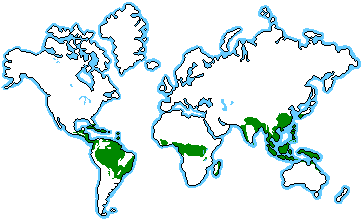Jungles is the 8th episode of the BBC TV series Planet Earth. It makes a rapid tour around the tropical belt and highlights a few key phenomena and spectacular behavior including mating dance of bird of paradise, forest regeneration after a treefall, plant-animal interactions in the forest canopy, fig trees as a keystone species, primate territoriality, forest sounds, mating leaf frogs, water cycle through evapotranspiration, nutrient cycle through decomposition, food webs, parental care in insects, fungal parasitism, gliding calugos, carnivorous pitcher plants, symbiosis, forest elephants gathering around a salt lick and chimpanzee warfare.
The episode starts with mating display of bird of paradise from New Guinea. The sexual display performed by males of this diverse group of birds are so elaborated that biologists studying sexual selection have been observing them with great interest for a long time. There are 39 species of birds of paradise. All have evolved from a single unsuspecting ancestor:
A phenomenon hugely influential in tropical rainforest development is the treefall gap dynamics. Treefalls are natural disturbances that create different environments and change species composition. Because of treefalls, forests consist of “mosaics” of patches at different stages of growth. Some patches are large created by multiple trees linked to one another with a network of lianas. The connectedness can be a double edged sword. Lianas can stabilize canopies but once a tree starts to fall it may bring down others through the “domino effect”. Gaps inside the forest canopy can be as small as a falling branch and can be as big as a football field. Light is the number one limiting factor for plant growth in a forest. Sun-loving (heliophilic) species such as Macaranga (Euphorbiaceae) of the Old World tropical forests or the Cecropia (Urticaceae) of the Neotropical forests are some of the first colonizers in a light gap. Interestingly, both plant groups are myrmecophytic that is they have a special biological alliance with ants. Life around another heliophilic tropical plant is astoundingly recorded in the documentary “Hotel Heliconia”.
Uprooted trees in treefall gaps can expose soil layers that are not accessible to many animals. This increases the availability of soil nutrients including potassium (K). K represents 2.6% of the weight of the Earth’s crust. Soil clay minerals contain K ions. Potassium is the second most abundant nutrient after nitrogen (N) in leaves. It has some suprising properties such as helping formation of rain clouds. Potassium containing aerosols can serve as cloud condensation nuclei in tropical forests.
Plants synthesize a staggeringly diverse array of toxic secondary metabolites to protect themselves from herbivores. The scene with the African forest elephants wonderfully demonstrates how K containing clay attracts many animals who seek those exposed locations for detoxification of plant toxins such as tannins in their diet. For example, Macaws in Peru have been observed to congregate around clay licks called “Colpa” by indigenous people. The phenomenon of ingesting soil is called geophagy. It is committed by many animals including Humans. Salt licks attracts so many animals in one particular spot as recorded in this short clip from the Amazon rainforest:
Tree canopies are the most diverse section of a tropical forest. To better understand the forest canopies, an ambitious project called Carnegie Airborne Observatory uses an aircraft fitted with laser scanners to generate digitized 3-D canopy structures. This approach proves to be very useful in many fields such as in estimating carbon storage of forests. There’s a similar campaign by NASA Goddard’s LiDAR, Hyperspectral and Thermal (G-LiHT) Airborne Imager in temperate forests of North America.
The documentary shifts the attention from the general of the forest towards a particular tree genus found both in tropical and temperate zones. Tropical fig trees serve as a keystone species affecting many species. Figs are a successful plant genus occurring in many continents. A procession of primates, birds and insects feed on figs. For chimpanzees figs are a regularly visited resource and lead to territorial wars for possession/access of fruiting trees. Figs have fascinating biological adaptations and have evolved a symbiotic interaction with tiny wasps for pollination. These wasps can effectively carry pollen quite far away. Based on a genetic study in Panama a single fig tree can pollinate others within 632 square kilometeres!
Red eyed green frog (Agalycnis spp.) mating is another spectacular event visible to few lucky visitors of Neotropical forests. Red eyed green frogs live high up in the forest canopy and only come down to swamps to breed in large numbers. Egg production is costly compared to sperm therefore not all females can be reproductively ready when the mating time comes. There’s always fewer females to mate compared to males. Scarcity of females leads to intense competition. Loud display calls by males advertise their quality. Males have to wrestle with other males in order to secure their mates. This theme repeats in many externally reproducing species including horseshoe crabs, polychete marine worms and fish.
In frog life cycle tadpole stage is one of the most vulnerable. There are many predators lurking inside and outside of water. Red eyed green frogs differ from other frog species and lay their eggs on vegetation hanging over the water. If a predator attacks eggs, tadpoles can hatch prematurely and throw themselves into the water below.
Fungi play an immensely important role in nutrient cycling by decomposing organic matter. Symbiotic partnership between a subterranean fungus and leaf-cutter ants has lead to one of the most prolific herbivory complex ever. A mature leaf cuttervant colony can consume an amount of leaves equal to a weight of a cow every day. Effects of fungi can be large on the ecosystems. Some even suspect that the cloud forming seeds may have been partly originated from fungal spores. As we see here, fungi can be lethal parasites. Chythrid fungi has been decimating frog populations. The documentary shows another insect killer fungus first discovered by Alfred Russel Wallace in 1849. Since this documentary was made it’s scientific name changed to Ophiocordyceps based on new DNA based scientific update. Parasitism of the ants by fungi goes back to 48 million years as the characteristic bite marks in fossil leaves from Messel Pit Germany shows:
Pitcher plants (Nepenthes spp.) have been a subject of many tropical documentaries including Ants, Nature’s Secret Power. Their adaptation for nutrient acqusition is so remarkable that they get filmed again and again with more interesting new things discovered about them. Researchers have found that some pitcher plants from Borneo can adjust the slipperiness of their trap rim called peristome. This exploits the scouting behavior of ants and help lure more ant workers.
Modern day tropical forests have lost their megafauna through an evolutionary time period know as the Pleistocene extinction. Many tropical trees still carry striking fruit characteristics as an adaptation to the long-dead megafauna These trees produce fruits with protected seeds which can only germinate when the hard shells are broken open by large animals. A prominent tropical biologist Daniel H. Janzen suggested that gomphotheres (extinct elephant-like animals) may have previously been responsible for the dispersal of many such seeds. With their extinction, many tropical trees such as Spondias mombin (Anacardiaceae) became threatened suffering from an extremely limited ability to migrate.
Primates have always been a curious tropical species. Because of their close kinship with us observations of their natural behavior is particularly informative for understanding Human nature. Here, the documentary exposes how African chimpanzees hunt colobus monkeys and consume meat. Previously we saw how Chimps can be territorial and defend certain valuable resources such as the fig trees. Here the interaction is between two species (interspecific) but behavioral scientists have observed violent warfare (intraspecific competition) and even cannibalism among chimp groups. This topic has been featured in a Disney Film The Chimpanzee.
In our fast changing world, the tropics are simultaneously responding forcings exerted by Human induced climate change. Scientists are suspecting that as the World becomes warmer the tropical belt is expanding. Such an expansion may push regions currently experiencing Mediterranean climate into more arid conditions. The Inter-Tropical Convergence Zone (ITCZ) is also showing signs that it is shifting. Past climate records have revealed that ITCZ used to be at lower latitudes (currently hovering around 6 degrees latitude). Analysis of sediments in Pacific Island lakes show that the band is at 3°N to 10°N. This is as far north as it has ever been in at least 1,200 years. The ITCZ band could shift north by five degrees by 2100 if the climate continues to warm at current rates. Such a shift could dry out precious agricultural land for millions of people in Ecuador, Colombia and elsewhere. Shifts in ITCZ have been observed in Central America between AD 700 and AD 900, suggesting global climatic changes at that time. These shifts in the tropical rain belt may have contributed to the declines of both the Tang dynasty in China and the Classic Maya in Central America.




1 Comment